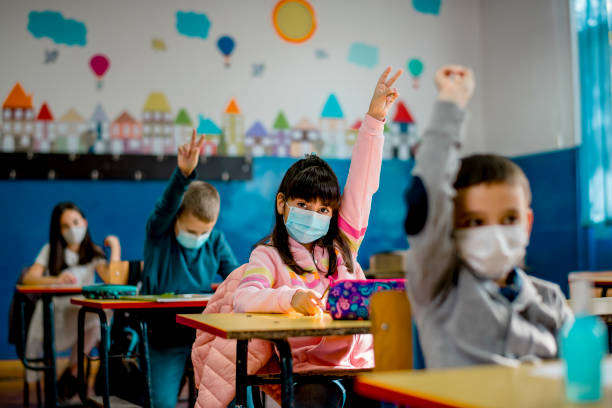
A new report from Michigan State University provides further insight into how Michigan students fared during the pandemic.
(MSU Today - Kim Ward) - Ongoing research provides further evidence that learning slowed in the challenged 2020-2021 school year, which is consistent with national trends.
MSU’s Education Policy Innovation Collaborative, or EPIC, also found that some students were more impacted, depending on their race/ethnicity, income level and the number of months they learned remotely in the 2020-21 school year.
EPIC is the strategic research partner of the Michigan Department of Education, or MDE. The report is based on new data collection and reporting requirements mandated by the Michigan Legislature for local school districts beginning in the 2020-21 school year.
This is the second in a series of reports to provide insight into Michigan students’ progress toward learning goals during the COVID-19 pandemic. It will be presented to Gov. Gretchen Whitmer as well as the Senate and House Education committees.
For the first time in 2020-21, benchmark assessments such as the NWEA MAP Growth assessment – the test used by the majority of Michigan school districts – were required by the state as part of the “Return to Learn” law. Tests like the NWEA MAP were given at least twice during the year to measure student progress toward academic goals. The Michigan Student Test of Educational Progress, or M-STEP, which was taken in person by some students at the end of the 2020-2021 school year, assesses students’ knowledge of grade-level material at the end of the year.
This latest report examined patterns across groups of students and found that lags in achievement growth were greater for female, Black, and low income students, and students who learned remotely for more of the school year. The previous report showed that on average, students made less than normal learning progress in 2020-21 as measured by the different tests included in the study. Those results were also consistent with national trends for last year during the pandemic.
“This report is further evidence that time in school matters,” said State Superintendent Dr. Michael Rice. “Time matters, and in-school time matters. Students and staff worked hard last year when remote, but it is difficult to recreate the time and value of in-person learning when remote for many of our children, particularly those most vulnerable — children with substantial disabilities, young, fledgling readers and English learners.
“This report also reflects unfortunate national trends that show the pandemic reduced the amount of learning that would normally have been expected during the school year,” Rice said. “Students progressed, but unsurprisingly not as fast as they otherwise would have in the absence of the disruption of the pandemic.”
Black, Latino/a/x and low income students were more likely to start and end the year significantly behind grade level, the data found. As identified in the first report, 27% of 4th-grade students who took the NWEA MAP Growth Math assessment were considered significantly behind grade level in the fall, increasing to 33% in the spring. These percentages were much higher for Black students (49% in the fall and 66% in the spring) and Latino/a/x students (35% in the fall and 43% in the spring) than for white students (21% in the fall and 24% in the spring) and Asian students (9% in the fall and 10% in the spring). These patterns are generally consistent across grade levels, subjects and test providers. The report found similar disparities for low-income students.
In addition, many pre-existing achievement gaps grew wider over the course of the school year. Across nearly all grade levels and subjects, gaps in the percentages of students who are significantly behind grade level, as well as gaps in average test scores, grew over the course of the school year for Black and Latino/a/x students (compared to white students). Gaps grew as well for low-income students compared to students from higher income households. In most cases, test score gaps between special education students and general education students increased as well.
Students also were less likely to maintain or improve upon their M-STEP math and English language arts proficiency levels from 2019 to 2021, said the report, compared to students who took these assessments in 2017 and 2019.
Of students who previously scored “Not Proficient” in mathematics on the 3rd grade M-STEP, only 9% scored in a higher proficiency level two years later as 5th graders in 2021 compared to 18% of “pre-pandemic” students who scored “Not Proficient” as 3rd graders in 2017 and took the 5th grade assessment in 2019). Math and reading achievement growth during the pandemic consistently lagged pre-pandemic growth rates, particularly for female, Black and low-income students.
The type of learning offered by districts in 2020-2021 also had an impact on student learning. Districts that offered in-person instruction all year fared better than those that were remote, with gaps between these groups of districts widening over the course of the year.
Districts that offered an additional month of remote schooling had nearly one percentage point more students scoring “significantly behind grade level” on math assessments by spring 2021. Similarly, an additional month of in-person schooling was associated with one-half a percentage point fewer students scoring “significantly behind grade level” on reading assessments. Multiple analyses confirm these results, suggesting that districts that offered only remote instruction throughout the 2020-21 school year experienced a reduction in math achievement growth that was twice as large as that for in-person districts.
According to Katharine Strunk, director of EPIC, and the Clifford Erickson Distinguished Professor of Education Policy at MSU’s College of Education, these findings are not surprising, but should be cause for alarm.
”We are seeing the same patterns in Michigan as we are seeing across the country — the pandemic has substantially impacted student learning, and these impacts are far worse for traditionally disadvantaged students,” Strunk said. “Achievement gaps grew during the pandemic and students who were already more likely to perform worse on achievement tests were the hardest hit. This is a major equity concern that will have long-lasting impacts on students’ lives.”
Because of the pandemic, not all students could be tested consistently throughout the year in 2020-2021. The report emphasizes that these unique challenges with test administration and participation resulted in imperfect and incomplete information on student learning.
Students who participated in either the benchmark or M-STEP assessments were more likely to be white and less likely to be low income or eligible for special education or English learner services, compared to the overall population of Michigan students. These differences are particularly stark in the 2021 M-STEP data, partly because most remote students did not take the M-STEP. Although many remote students did participate in benchmark assessment testing, patterns in the data suggest that some of them (particularly those in younger grade levels) may have had assistance from their caregivers at home while taking the test, making it more difficult to discern true skill levels from the assessments.

 5/2/24 - It's The National Day Of Prayer
5/2/24 - It's The National Day Of Prayer
 4/26/24 - Saturday is National Prescription Drug Take Back Day
4/26/24 - Saturday is National Prescription Drug Take Back Day
 4/24/24 - Senate Passes Foreign Aid Bill
4/24/24 - Senate Passes Foreign Aid Bill
 4/23/24 - Nursing Home Changes
4/23/24 - Nursing Home Changes
 4/19/24 - UPDATE: Christian Music Artist Mandisa Has Passed Away - Tributes
4/19/24 - UPDATE: Christian Music Artist Mandisa Has Passed Away - Tributes
 4/19/24 - Israel Carries Out Military Strike Against Iran
4/19/24 - Israel Carries Out Military Strike Against Iran
 4/18/24 - Ford Issues Another Recall For Some Broncos
4/18/24 - Ford Issues Another Recall For Some Broncos
 4/15/24 - Reaction After Iran Attacks Israel
4/15/24 - Reaction After Iran Attacks Israel
 4/15/24 - TAX Day - File By Midnight
4/15/24 - TAX Day - File By Midnight
 3/26/24 - A Major Bridge Collapse In Baltimore
3/26/24 - A Major Bridge Collapse In Baltimore
 3/20/24 - FBI & IRS Warn Of Illegal Charities, Donation Scams
3/20/24 - FBI & IRS Warn Of Illegal Charities, Donation Scams
 3/15/24 - James Crumbley Also Found Guilty
3/15/24 - James Crumbley Also Found Guilty


